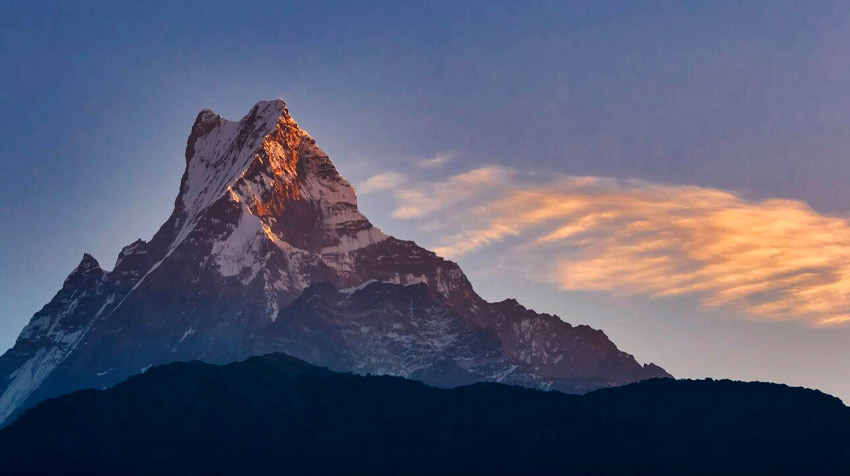Trip Overview
The Machhapuchhre Trek is an excellent choice for trekkers seeking a moderate challenge combined with stunning natural scenery and cultural richness. Its relative obscurity compared to other treks in Nepal makes it an ideal option for those looking to explore the less-travelled paths of the Himalayas.
The Machhapuchhre Trek, also known as the Mardi Himal Trek, is a captivating journey in the Annapurna region of Nepal. Named after the stunning Machhapuchhre peak, also known as "Fishtail Mountain" due to its unique shape, this trek offers adventure, natural beauty, and cultural immersion. It is a relatively new route compared to the more popular treks in Nepal, providing a less crowded and more intimate trekking experience.
The trek typically begins from the vibrant city of Pokhara, a central tourist hub and gateway to the Annapurna region. From Pokhara, trekkers make their way to Kande or Phedi, the traditional starting point of the Machhapuchhre Trek. The route ascends through dense rhododendron forests, lush green hills, and picturesque villages, offering spectacular views of the Annapurna range, including Annapurna South, Hiunchuli, and, of course, the iconic Machhapuchhre peak.
One of the highlights of the Machhapuchhre Trek is the Mardi Himal Base Camp, which stands at approximately 4,500 meters. The base camp provides a close-up view of the majestic Machhapuchhre and panoramic vistas of the surrounding mountains. Trekkers often experience a sense of solitude and tranquillity here, away from the bustling crowds on other popular trekking routes. The trail is well-marked, with accommodations from basic tea houses to more comfortable lodges, ensuring trekkers have a pleasant stay throughout their journey.
Cultural encounters are another significant aspect of the Machhapuchhre Trek. The route passes through traditional Gurung and Magar villages, where trekkers can experience the warm hospitality of the local people and learn about their unique customs and traditions. These interactions provide a rich cultural context to the trek, enhancing the overall experience.
The best seasons to embark on the Machhapuchhre Trek are pre-monsoon (March to May) and post-monsoon (September to November). During these times, the weather is generally clear, offering the best views of the mountains and pleasant trekking conditions. However, the trek can be undertaken year-round, offering a different perspective on the landscape and flora each season.
Itinerary
Cost Include
- Trekking permit fees as per program
- ACAP Fees and TIMS Permits
- Food for trekking (Breakfast, lunch, dinner) in community House or camp.
- All Camping & Kitchen equipments
- Trekking Guide & necessary porters.
- Local transportation Airport – Hotel – Airport by private vehicle
- Accommodation in Kathmandu and Pokhara on bed & breakfast basis
- Trekking insurance with Medical insurance for trekking staffs
- Trekking allowance, food allowance for trekking crews
- Land transportation for Trekking staffs
- All Government Tax &Service charge to company
Cost Exclude
- Personal equipment for Trekking like Trekking poles & Sleeping bag
- Personal Insurance for travel to Nepal
- Lunch & dinner in Kathmandu and Pokhara
- Emergency Rescue evacuation if needed
- Personal expenses
- Personal Tips for staff
- Filmy permit for National park only for shooting camera
- Bar bills & Beverages
Equipment list for Machhapuchhre Trek
This checklist is designed to help you prepare for a trekking holiday in Nepal, with additional notes for those attempting to summit a trekking peak. It's reassuring to know that high-quality gear, including outdoor clothing and sleeping bags, can be conveniently rented in Kathmandu.
Most treks will be in lodges or teahouses, which offer basic rooms with two single beds and mattresses. These lodges, with their cozy rooms and provided blankets, ensure a comfortable stay, making your trek a more enjoyable experience. A good-quality three-season sleeping bag should suffice. However, for trekking peaks, you'll generally set up base camp with tents, necessitating a warmer sleeping bag, a liner to enhance its warmth, and a sleeping mattress.
| TRAVEL DOCUMENTS | HEAD |
| Debit/Credit Cards | Sun Cap |
| PP Size Photo (2 Pieces) | Fleece Hat/ Warm Hat (1-2 Pcs) |
| Insurance Paper And Contact Address. | Neck Gaiter (2 Pcs) |
| Family Members / Company’s Contact | Head Lamp with extra batteries |
| Address | Sun Glasses (UV Protection) |
| Travel Insurance | Balaclava |
| HANDS AND FEET | UPPER BODY |
| Light Liner & Down Gloves | Thermal Top Base Layer (2 Pcs) |
| Normal Socks (5-6 Pairs) | Fleece Jacket (1 Pcs) |
| Trekking Shoes | Gore Tex Jacket (1 Pcs) |
| Slipper (1 Pair) | Down Jacket (1 Pcs) |
| Camp Shoes | Quick Dry T-Shirt (2 Pcs) |
| Hiking Boot with ankle support | Wind breaker/Windproof Jacket |
| LOWER BODY | PERSONAL EQUIPMENT |
| Thermal Bottom Base Layer (2 Pcs) | Down Sleeping Bag -10°C to -20°C |
| Fleece Trouser (1pcs) | Headlamp (Rechargeable Batteries) |
| Gore Tex Pant (1 pcs) | Trekking Pole |
| Light Weight Quick Dry Trekking Pants(2-3 Pairs) | Rucksacks 35L - 45L/Day Bag |
| Gaiters for trekking boots | Rain Pancho & Umbrella |
| Under Wear (4 pcs) | Powerbank |
| EATING & DRINKING | TOILETRIES |
| Energy Bar | Hand Disinfectant |
| Snacks | Wet Tissue |
| Water Bottle | Tooth Paste & Tooth Brush |
| Thermos | Soap & Shampoo |
| MEDICAL/FIRST AID | MISCELLANEOUS |
| Severe Pain Killer (Flexon) | Lip Balm |
| Mild Pain Killer (Paracetamol) | Sunscreen |
| Throat Lozengen (Strepsils) | Moisturizer |
| Lubricating Eye Drop (Artificial Tear) | Quick Dry Towel |
| Antacid Tab | Trails Maps |
| Electrolyte Tab | Trekking Poles |
| Handy Plast | Sun Cream (30-50 Spf) |
| Blister Blast | Lip Guard (30-50 Spf) |
| Crep Bandage (Elastic Bandage) | Sun Glasses (UV Protection) |






 Share
Share
 Download
Download










